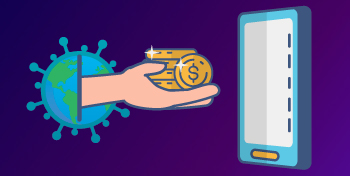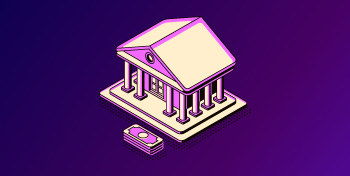Many people living in certain conditions, both political and economic, and geographical, without having wide access, and no access at all to traditional banking, most likely have heard about cryptocurrencies.
The symbiosis of the two financial worlds
Regardless of your opinion about Bitcoin’s chances of becoming digital gold, the underlying blockchain technology (or distributed ledger technology) has spawned a new trend that has excited everyone, both cryptocurrency advocates and traditional finance advocates. And this trend is called DEFI-decentralized finance.
As central banks begin to develop their own stable digital coins, and financial institutions explore the transformative potential of distributed ledger technology, smart contracts, and decentralized applications (dApps), interest in this space is not limited to the niche of tech-savvy cryptographers. Moreover, the broader financial services industry is paying attention. So, let’s find out more.
- What is DEFI?
DEFI refers to any financial system that has been structured to operate without a centralized function.
To illustrate what DEFI is (and what it definitely isn’t), let’s use a simple example.
You want to pay your friend, who works as a baker, for bread, he offers you the opportunity to pay with his debit card, so you attach your debit card to the terminal.
The process of transferring money between you and your friend requires your bank, your friend’s bank, a payment network (such as VISA or Mastercard), and a terminal / gateway provider. This is not DEFI! The delivery mechanisms in this case are all centralized, and there are many of them.
In a decentralized version of the same transaction, your digital wallet will interact directly with your friend’s digital wallet, and then the transaction will be verified in a distributed registry that is not owned by any company or organization.
Peer-to-peer payments are indeed the simplest example to describe DeFi, but with the use of smart contracts, these projects are diversifying into increasingly complex areas of financing, from lending to trading, from savings to insurance, and more.
This is a kind of paradigm shift. Especially when people in many cases do not even really understand what happens when their card gets into the terminal.
So, let’s figure out why you need DeFi at all

Many centralized financial systems are outdated and slow to operate. Have you ever tried to send money to another country? There’s no technological reason why these transactions shouldn’t happen in milliseconds, but they can take anywhere from 2 to 5 days.
But not only speed and modernity can be an excuse for DeFi, consider security as well. Centralized systems (especially legacy ones) they may be vulnerable to a new generation of sophisticated hackers. Reputable financial institutions and their centralized systems can be vulnerable to data leaks, fraud, and security issues. And it is customers who initially suffer from these security breaches due to the blocking of their apps, digital banking, and card reissues.
DeFi aims to address three challenges in crypto finance: scale, pace, and security, while remaining fully decentralized.
Now that the testing ground for all this is in the crypto space, the framework designed for this allows us to see how this can be applied to fiat currencies in a broader sense – to financial services in large volumes.
So, what are the benefits of DeFi?
First of all, interaction with the DeFi system is not limited in time. So they are available 24 hours a day, 365 days a year. In addition, they are available wherever there is an internet connection, so they are not flexible in terms of time and location. They are permanent.
In addition, they tend to be cheap because they use technology to be as fast and scalable as possible, but also because of the lack of intermediaries, developers can offer significantly lower fees and fees.
And finally, perhaps most importantly, they offer a way to address the problem of people “not covered by banking services.” A segment of any population that, due to isolation, lack of funds, lack of credit history, or (in some cases) political or socio-economic oppression, cannot participate in the existing financial system.
DeFi strives to be fast, secure, cheap, affordable, and egalitarian. That sounds great!
Let’s take a look at some of the best DEFI’s in the world.
Who does what?

To explore the world of DeFi projects, let’s look at three separate categories. The first is the initiator, the second is the lender, and the third is the interest rate protocol.
- Influence factor – Algorand
Algorand is a platform for creating DeFi projects. Its goal is to remove the technical barriers that have hitherto hindered blockchain and decentralized ledger projects.
They seek to promote the attraction of new financial assets to the chain, the creation of new tools and services, and the expansion of transaction methods and the exchange of value.
With a Turing Award winner as its founder, and employees who have moved on from IBM, Google, and Mozilla, with credentials from the Ivy League and MIT, they represent a serious organization that wants to allow businesses to use decentralized finance.
- Lender – AAVE
AAVE has launched a financial instrument called “Term Loans”, which is the first unsecured loan option in the decentralized finance space.
Designed for developers, AAVE loans allow you to borrow any available amount of digital assets without providing any collateral, provided that the liquidity is returned to the protocol within a single block transaction.
This highly technical knowledge transaction is an example of how the lending mechanism and provisions guaranteeing the security of funds in the reserve pool (and the complexity of the necessary contracts) can be changed by DeFi.
- Staking Protocol – Compound Labs
Compound Labs is an open source software development company that creates products and services for decentralized finance.
The basis of the protocol is that any person who owns cryptocurrencies can receive interest in the same way as those who have rubles in a bank savings account.
This algorithmic stand-alone staking protocol can be used by platforms or wallets to incentivize the secure storage of digital assets by their customers. However, this can also be applied to any central bank-issued stable coins that will be created in the future.
Compound aims to support, manage, and audit a publicly verifiable and secure interest rate protocol that uses smart contracts to provide secure and stable returns on digital assets.
So, as you can see, this is a pretty technological thing.
But, as with fintech, stacking is that technologists can develop better systems, processes, methodologies, and delivery mechanisms outside of large (and in some cases slow) financial services organizations, and then help these same established financial service providers change their business models by incorporating the best of what has already been developed, tested, and validated.
What is the future of DeFi?
Decentralized finance projects develop in an environment associated with cryptocurrencies and digital assets, and therefore limited rules apply to them.
But, as with any new technology, the maturation of these projects and the inevitable failure of some of them will create a safer and less risky space for innovation, while ensuring proper KYC/AML procedures, and compliance with an adequate regulatory framework.
At the point where fintech and DeFi are juxtaposed and merged with traditional systems, we will have a real tipping point where nascent financial technologies are just a part of the new financial technologies.
The world needs to realize the dream of a fast, safe, cheap, affordable and egalitarian financial space.


